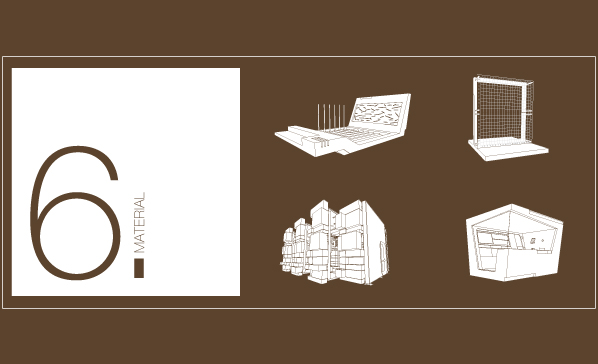The Sixth Material + + + + + + + + + + + + + + + + + + +
Information as the par excellence factor in order to transform energy into architecture in the times of digital reality and communication revolution.
Abstract 18.02.2008
Daniel HORA – Marianna MILIONI

The processing of this dissertation probes into exploiting the data of today’s societies, in order to approach new and innovative strategies and methodologies in the field of architecture and urban planning. The results of the project are to be deduced from a theory quest constantly interacting with praxis – that is experimental projects in the form of prototypes. Through the study of the prototypes, their interaction with their surroundings and the evaluation of their effects, the dissertation material is collected.
It is with information and communication technology that architecture and civil engineering open themselves to a completely new world. It is information above all, that is becoming an essential component of the new architecture and the new urban environment. Forward-looking architects around the world are attempting to create a generation of buildings and spaces that are ‘conscious’ of the changes in the operational and social framework caused by information technology and capable of expressing this revolution.
Architecture’s new construction material is information. The sixth building material after wood, stone, concrete, steel, glass and textile is the information.
Information – actually its collection, classification, diffusion, transmission and above all formalisation and operationalisation – is the driving force behind the change that we witness nowadays. It is true that the motor that has enabled this new development is the digitalisation of the data. But the whole procedure wouldn’t have this impact if it wasn’t for the thinking mind, which is the true issue of the information revolution. The key issue of their mutual influence is interactivity.
The objectives of this dissertation expand in exploring methods of interpreting society data into architecture and architecture back into theory. Strategies are investigated through this project in order to use this social data, this information potential in order to arrive to an updated, an interactive architecture.
The upshot of the dissertation is implemented through a constant interaction between theoretical research and experimental praxis, in the form of interactive prototypes. We install diverse micro-architectures (or systems) in order to analyse the urban behaviour. These prototypes function as provocation factors in the city – in the reality itself – through their physical interactivity, namely the fact that the architecture itself changes. The provocation is in constant motion. So actually, the research experiments are momentary inquires. During their sojourn, through the communication and the interaction with the visitors, the prototypes supply information. The material supplied by a prototype is investigated over again, in order to provide the necessary information for the construction of a new prototype. Through these prototypes, extracting conclusions from one in order to design the next, we explore urban moments.
These prototypes function as tactical, flexible and digital, more operative cartography: evolutionary models of simulation and development, intended to select bits of basic information (and situations) related to abstract elemental codes (precise and indeterminate at the same time). Through the prototypes, the results of mobility, interchange, migration and communication are mapped. Therewith, this research endeavours to compress meaningfully not so much the reproduction of the whole reality, or part of it, but rather a representation – a scanning – of its most strategic bits of information. The prototypes are open, connectable in every dimension, breakable, reversible, and always modifiable, just like the medium of architecture they are modelling; actually they represent spaces of experimentation.
If we analyse the architecture history from the 50s up to now, we see that it is no coincidence that we come to these thoughts. In the 60s, utopias were deployed, but no realistic urban behaviour models. They were futurist, anti-heroic and pro-consumerist, drawing inspiration from technology in order to create a new reality that was solely expressed through hypothetical projects. Committed to a 'high tech', light-weight, infra-structural approach that was focused towards survival technology, great architects of the time experimented with modular technology, mobility through the environment, space capsules and mass-consumer imagery. Their works offered a seductive vision of a glamorous future machine age; however, social and environmental issues were left unaddressed.
This thesis is distinct from the utopias of the 60s: we make no closed utopias; we rather live from the moments, which are constantly actualised
These prototypes, as spaces created through information and in order to provide information, are temporary. Provocation is an act that causes a response and its boundaries have changed nowadays. The experimental prototypes act as territories for representation, simulation or recreation. The whole procedure aims to be a ceaseless dialogue between man and architecture. Their existence depends on the relationship city-citizens. Furthermore, it is due to their presence and their functions that the city is in a condition of continuous adaptation. This perpetual interactive dialogue between the city and the prototype is considered fertile as long as it accommodates the participants’ needs for aesthetic and recreational desires. There is no secure way to estimate the duration of this mutual influence. The system is constantly active and the results of its affection dictate the continuity.
“Interactivity may serve to focus contemporary thought on an architecture that, having overcome the objectivity of our needs, can respond to the subjectivity of our wishes.”[1]
Through this doctorate we register the numerous variations of the theory and the thought. This work doesn’t try to invent formulas; it represents just an impulsion to alteration. After all, to represent a reality is to begin to transform it.
[1] Saggio, A., 2006, Digital Real, article posted in http://www.ntua.gr/archtech/forum/digital%20%20real_files/mainframe.htm